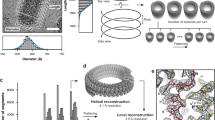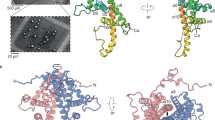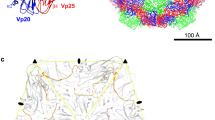Abstract
FOR some time we have been examining with the electron microscope thin sections of caterpillars infected with their polyhedral diseases. In this way it is possible to follow the development of the disease, to see the crystal-like polyhedra as they are formed in situ and to observe the fine structure of their contents.
This is a preview of subscription content, access via your institution
Access options
Subscribe to this journal
Receive 51 print issues and online access
$199.00 per year
only $3.90 per issue
Buy this article
- Purchase on Springer Link
- Instant access to full article PDF
Prices may be subject to local taxes which are calculated during checkout
Similar content being viewed by others
References
Bergold, G., Z. Naturforsch., 2 b, 122 (1947).
Bergold, G., Z. Naturforsch., 3 b, 25 (1948).
Hughes, K. M., J. Bact., 59, 189 (1950).
Steinhaus, E. A., Bact. Rev., 3, 203 (1949).
Author information
Authors and Affiliations
Rights and permissions
About this article
Cite this article
SMITH, K., WYCKOFF, R. Structure within Polyhedra Associated with Insect Virus Diseases. Nature 166, 861–862 (1950). https://doi.org/10.1038/166861a0
Issue Date:
DOI: https://doi.org/10.1038/166861a0
This article is cited by
-
Structural Organization of Baculovirus Occlusion Bodies and Protective Role of Multilayered Polyhedron Envelope Protein
Food and Environmental Virology (2016)
-
Iridovirus and cytoplasmic polyhedrosis virus in the freshwater daphnid Simocephalus expinosus
Nature (1975)
-
Untersuchungen �ber die Polyedrose von Neodiprion sertifer (Geoffr)
Archiv f�r die gesamte Virusforschung (1955)
-
An Unusual Virus Disease of a Dipterous Larva
Nature (1954)
-
Cytoplasmic Polyhedral Virus Diseases
Nature (1952)
Comments
By submitting a comment you agree to abide by our Terms and Community Guidelines. If you find something abusive or that does not comply with our terms or guidelines please flag it as inappropriate.



